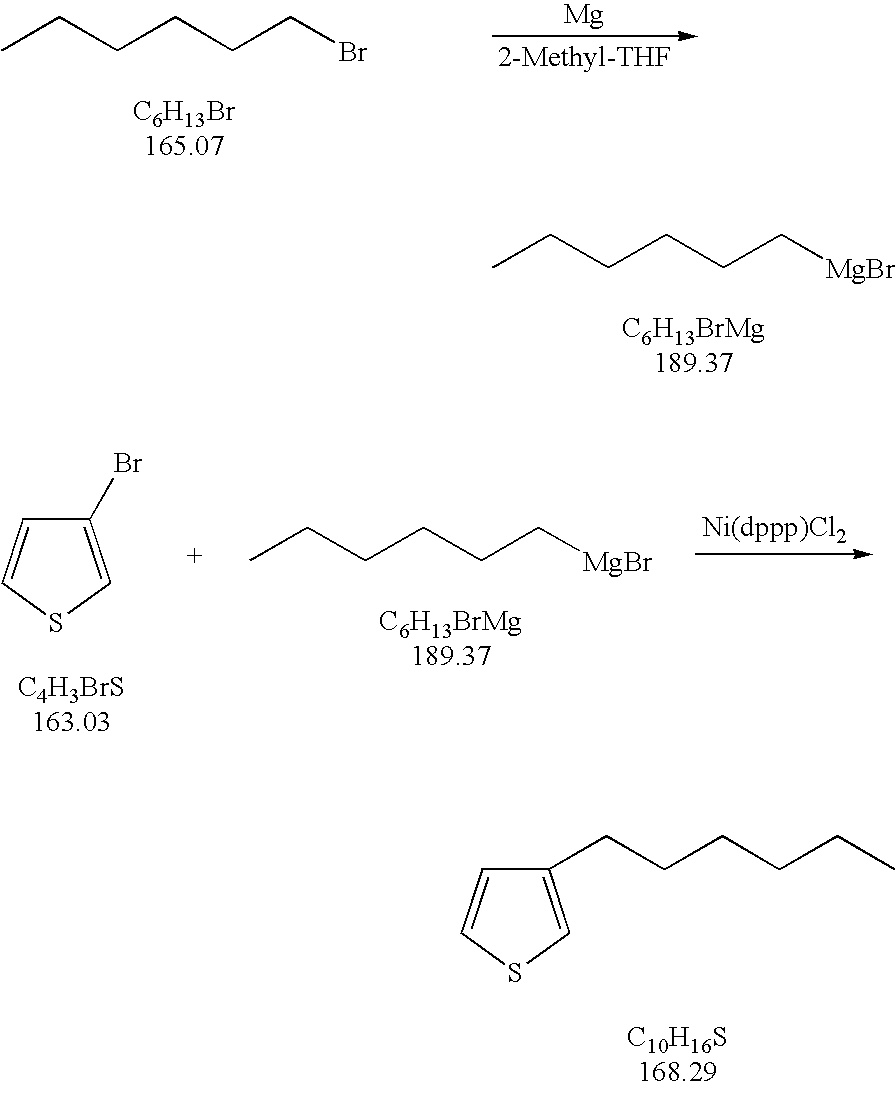Process for the kumada coupling reaction
a technology of kumada and coupling reaction, which is applied in the field of process for kumada coupling reaction, can solve the problems of difficult processing, insoluble, and limit the desired product yield
- Summary
- Abstract
- Description
- Claims
- Application Information
AI Technical Summary
Problems solved by technology
Method used
Image
Examples
example 1
[0023] Added to a flask are 57.1 g (2.35 mol) of magnesium metal and 700 ml of 2-methyl-tetrahydrofuran. The flask contents are heated to 60-70° C. A reaction is initiated by adding 5 ml of hexylmagnesiumbromide (1 N) in 2-methyl-tetrahydrofuran to the flask. The Grignard reagent concentration in the solvent is 3.35 mol / L. The flask temperature is increased to 80-85° C. Next, 396 g of bromohexane (2.4 mol) is added to the flask over a period of 2.5 hours. The flask is then heated to reflux and stirred for an additional two hours. After two hours, the flask is cooled down to 15-20° C. Thereafter, add a suspension of 1.6 g of Ni(dppp)Cl2 catalyst in 5 ml of 2-methyltetrahydrofuran. Next, over a period of four hours, add 326.1 g (2 mol) of 3-bromothiophene. Let this stir for an additional 16 hours. The reaction mixture is then hydrolyzed on 1000 ml HCl (10% w / w). A 100% conversion is achieved with essentially no bis-thienyl side-product, and a crude assay of 98.5%.
[0024] According to ...
example 2
[0025] Added to a flask are 58.3 g (2.4 mol) of magnesium metal and 500 ml of 2-methyl-tetrahydrofuran. The flask contents are heated to 60-70° C. A reaction is initiated by adding 5 ml of hexylmagnesiumbromide (1 N) in 2-methyl-tetrahydrofuran to the flask. The Grignard reagent concentration in the solvent is 4.8 mol / L. The flask temperature is increased to 80-85° C. Next, 396.2 g of bromohexane (2.4 mol) is added to the flask over a period of 2.5 hours. The flask is then heated to reflux and stirred for an additional two hours. After one hour, the flask is cooled down to 15-20° C. Thereafter, add a suspension of 1.6 g of Ni(dppp)Cl2 catalyst in 5 ml of 2-methyltetrahydrofuran. Next, over a period of four hours, add 326.1 g (2 mol) of 3-bromothiophene. Let this stir for an additional 16 hours. The reaction mixture is then hydrolyzed on 1000 ml HCl (10% w / w). A 100% conversion is achieved with no bis-thienyl side-product, and a crude assay of 98.5%. Immediate gas chromatography of t...
example 3
[0026] 1.2 mol of magnesium metal and 1.2 mol of 1-bromodecane are combined in a 100% 2-methyl-tetrahydrofuran solvent, and with 300 mg of (1,3-bis (diphenylphosphino)propane)dichloro Nickel (II) catalyst. The Grignard reagent concentration in the solvent is 2.6 mol / L. Next, 3-bromothiophene (1 eq.) is added to the flask. The reactions were conducted at room temperature. Immediate gas chromatography of the reaction product showed 27.1% 3-bromothiophene, 30.0% 3-decylthiophene and 0.9% bis-thienyl side-product. GC after one hour showed 0.0% 3-bromothiophene, 92.6% 3-decylthiophene and 2.3% bis-thienyl side-product. GC after 2.5 hours showed 0.0% 3-bromothiophene, 94.6% 3-decylthiophene and 1.9% bis-thienyl side-product.
PUM
 Login to View More
Login to View More Abstract
Description
Claims
Application Information
 Login to View More
Login to View More - R&D
- Intellectual Property
- Life Sciences
- Materials
- Tech Scout
- Unparalleled Data Quality
- Higher Quality Content
- 60% Fewer Hallucinations
Browse by: Latest US Patents, China's latest patents, Technical Efficacy Thesaurus, Application Domain, Technology Topic, Popular Technical Reports.
© 2025 PatSnap. All rights reserved.Legal|Privacy policy|Modern Slavery Act Transparency Statement|Sitemap|About US| Contact US: help@patsnap.com

